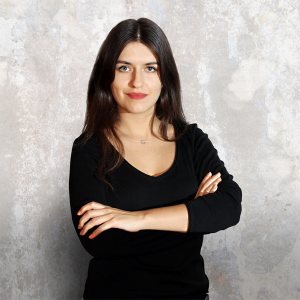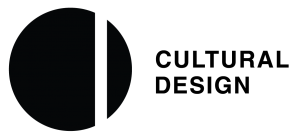Olga Skoczylas on The Time of Art-Driven Innovators
Weekly Excerpts #8: 21/02/2019
We have 3 weeks to go before the book launch of our guide. We want you to know exactly what to expect from the book and to get to know the amazing people behind this project! Every week you will be able to check in on our website in order to find a new essay, article, artist or business from the guide.
 This Weeks excerpt is focused on Olga Skoczyla, who is a design strategist with a masters degree in Cultural Economics and co-founder of the design agency ‘Cultural Design.’ She attended The Universal Sea – Pure Or Plastic?! exhibition in the Centre of Polish Sculpture in Oronsko and was inspired by the idea of utilising art for environmental innovation. Olga lives most of the year in Berlin, Germany, and enjoys working remotely from different parts of the world. As well as her business being featured in the book, an essay written by Olga is published in the Art & Innovation section of the guide.
This Weeks excerpt is focused on Olga Skoczyla, who is a design strategist with a masters degree in Cultural Economics and co-founder of the design agency ‘Cultural Design.’ She attended The Universal Sea – Pure Or Plastic?! exhibition in the Centre of Polish Sculpture in Oronsko and was inspired by the idea of utilising art for environmental innovation. Olga lives most of the year in Berlin, Germany, and enjoys working remotely from different parts of the world. As well as her business being featured in the book, an essay written by Olga is published in the Art & Innovation section of the guide.
About Cultural Design

Cultural Design studio is a Berlin based creative studio which builds products, services and experiences with a positive cultural impact. The company’s aim is to incorporate culture into the design process. Cultural Design functions by incorporating our values, emotions and identities into their designs. They believe that this creates a much stronger connection between people and their designs and can trigger positive cultural change.
Interview (from the guide as part of the Innovation chapter)
What is the problem targeted?
The goal is to redefine the product design process to include the consideration of cultural understanding and positive social and environmental impacts.
What is the solution, how does it work exactly?
We developed a new Cultural Design process that involves in-depth cultural research as a starting point for each design project. We also put a great focus on cultural impact. How will the designed product or service impact the world we live in? We think beyond the experience of individual users and plan for human- to-human social interactions, cultural change and environmental impact.
Who is the target audience?
We work with any organisation or business willing to get an in-depth understanding of the cultural, social and environmental contexts and impacts of their product or service.
Where can we find you?
We operate globally collaborating with various businesses and organizations from all over the world.
The Time of Art-Driven Innovators or What Can Artists Teach the Industry About Creativity?
Essay by Olga Skoczyla (from the guide as part of the Art + Innovation chapter)
Our contemporary economy is often described as a “creative economy.” The role of imagination and creativity is instrumental for innovation and economic growth. Already in 2004, writer Daniel Pink stated on the pages of the New York Times that “The MFA is the New MBA” (The Master of Fine Arts is the new Master of Business Administration). In the age when even the old-school corporations began appreciating the “right-brain” thinkers, the creatives, the imaginative souls, can artists and innovators work closer together? If we imagine the world where art has a crucial role in our society and economy, how would we go about integrating it with the non-artistic inquiries? One way to pursue that vision would be to teach the industry, the entrepreneurs and innovators about art as a process, a process which is not exclusively motivated by self-expression but rather has a utilitarian nature and can be adopted by industry practitioners to create more meaningful products and even radical innovation.
Creativity
The inherent common ground of art and innovation is creativity. Dave Zaboski, former illustrator and animation artist at Disney Animation Studios, describes creativity as an ability to imagine the unseen, “turning a thought into a thing.” Entrepreneurs, innovators and artists alike try to create something new. Instead of moving from a point A to B, as Amy Whither puts it in her book Art Thinking, they invent the point B and strive towards it. They envision the unseen point B. Art as well as innovation ends up being a type of improvisation. It doesn’t follow the common route, models, definitions but rather explores the unknown and undefined territories.
Purpose
Taishi Kamiya, a Japanese artist- engineer, coined the term “art interaction design” to bridge the gap between art and innovation processes. The established “design thinking process,” widely adopted in the fields of design, engineering and innovation, aims at solving problems in feasible and viable ways. As a result of asking the question, “how can we do it better?” the process often leads to only incremental innovation.
Art interaction design, on the other hand, shifts the focus from thinking about solutions to thinking about creative questions to ask.
Utilising the art interaction design process, creators end up spending a lot more time in the probing space which results in developing a meaningful and often abstract question to work with. The importance of “the question” also appears in the work of Amy Whitaker. Her “MDQ: Major Dramatic Question,” inspired by the screenplay writing technique, is a guiding question of your creative process. The question can be subjective, expressive, or intuitive.
It should be neither problem solving nor customer-oriented, it has to be breakthrough-oriented. Where the industry looks out to the users for problem definition, the artists look within to intuitive feelings and reactions to personal or societal problems. The question also does not necessarily have to be feasible; it has to be big, relevant, engaging. You can refer to the big creative question as your purpose, belief, or your drive for the creative action. As Dave Zaboski says, the first step of the art-inspired creative process would be to “cultivate clarity of intent capable of inspiration and dedication.”
Space
The big idea of art thinking forms around carving space for creativity. The space for creativity might be a physical space specifically designated for your creative pursuit. It can be managing your physical and mental energy and carving out space for creativity, for observation and discovery within the reality of time pressure, deadlines, and everyday responsibilities. Finally, the space for creativity can be interpreted as Amy Whitaker’s “studio time,” scheduled time for inquiry and learning, for contemplation over your big creative question. Although the creative process can be more abstract, it shouldn’t be chaotic. It requires nurture and practice within a designated space and time.
When defining the basis and the rules of your creative space, allow yourself playfulness and intuitive accidents. The well-known Plato quote about human relationships says,
“You can discover more about a person in an hour of play than in a year of conversation.“
We can think the same way about innovation. By allowing playfulness in your work on the creative question, you can get a better understanding of what you are striving for. The creative space should be a “space out of the ordinary” which allows for immersion in the creative activity and stimulates the change in your mindset different from the ordinary, the usual.
Process
Creative process can be messy. Whether it is creating a painting, writing a piece of music or coming up with a new tagline, it is rarely a straightforward linear process. Let us imagine you are writing a book. It is very likely you start with one idea but at some point in the process you realise you want to change the concept. You start over and pursue the second idea. But your friend calls you and tells you an interesting story that inspires you. You go back to writing and the story unfolds in a completely different way than you had planned. The creators at Disney looked at the process and discovered that linear understanding of the artistic process, from starting point A to final creative result B, is not only incorrect but limits the artists themselves from creative exploration and ultimately creative growth. What the team ended up coming up with, as an alternative shape to illustrate the process, is a spiral. Just like in nature, in flowers, the galaxy, and the proportions of the human body, the creative process also follows a spiral- like shape.
The spiral illustrates that in your pursuit of the point B you might take various directions, you might change the course of the idea, you might take a few passes. But all those actions and divergences ultimately take you closer to the final creative outcome. The iterations teach and inspire what the final outcome should or should not be like.
Acknowledging the spiral’s multiple turns frees you from the pressure and prepares you for constructive experimentation, prototyping and discovery.
What the spiral also teaches us is that the creator has to choose when the work is finished: when you zoom in the spiral you see that it is infinite. It is the role of the creator to establish when the outcome is final and ready to face the world.
Conclusion
When we look at art as a process, as another approach to channeling creativity, we notice that there are a lot innovators, entrepreneurs and
the industry can learn from artists. In the work of artist-innovators like Amy Whitaker, Taishi Kamiya and Dave Zaboski, we discover patterns in the artistic process which could be adopted by the industry to increase the potential of innovation. Working with a meaningful question, carving out space for creativity in our schedules and accepting the spiral nature of creative work are just some of the steps industry practitioners can take to experiment with the art-inspired creative process.
In the constraints of the current economic system, artists, entrepreneurs and innovators alike face many constraints while producing their original ideas. As Amy Whitaker puts it, “Economics as a system is pretty good at paying you for what you already can do, but it’s pretty bad to pay to you to experiment and try new things.” I believe, bridging the gap between the artistic creative process and the industry creative process will allow for more understanding and collaboration—ultimately leading to a larger and more united creative force that has the ability and resources to solve problems and create innovative solutions to improve the world.
Found out more about Cultural Design on their website.
Stay tuned for more Weekly Excerpts.
